Many teams use iSpring Learn because it’s simple, affordable, and gets training programs off the ground without a steep learning curve.
It shines for small to mid-sized businesses that need quick course authoring and a platform that doesn’t overwhelm admins or learners. Plus, the setup is simple, the tools are familiar, and it’s very cost-effective at a smaller scale.
But as companies grow, so do their learning needs, and what once felt easy now feels like a ceiling.
Furthermore, when learning tools can’t keep pace, programs often stall. Admins end up working harder than they should, and employees lose interest in clunky experiences.
Over time, that gap between what the system can do and what the business needs turns into wasted hours, missed insights, and stalled momentum.
That’s why so many teams in 2025 are rethinking their learning management system and weighing smarter alternatives.
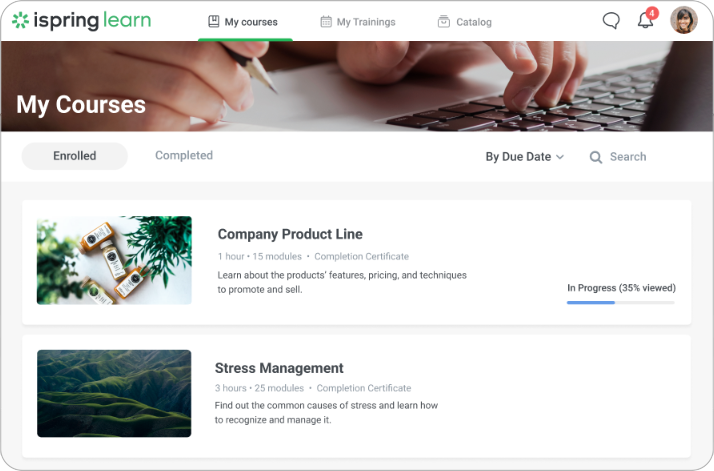
Top iSpring Learn Alternatives
- TalentLMS
- Docebo
- Absorb LMS
- Moodle
- Litmos
- Thinkific
- Tovuti
How to choose the right LMS for your needs
Every learning platform (aka LMS) can look good at the start. The promises of easy setup and smooth course delivery sound appealing, but the real test comes once the program is in full swing and your business starts growing.
Once you start growing, managers want reports that break down performance across departments. Learners will need a catalog that’s simple to navigate, even when dozens of courses pile up. Administrators need tools that save time instead of creating more manual work.
That shift is something users of iSpring Learn often talk about. In the early stages, the system feels intuitive, quick to set up, and easy for everyone to use. But as teams expand, cracks begin to show. One reviewer on G2 put it this way: “Ease of use, course creation, customer support all got high marks. However, we needed reports broken down by department and more flexibility with catalog ordering once our user base reached 250+.” (G2)
The problems raised in that review aren’t small details. When reports lack depth, managers struggle to see how learning is working across different departments. Without flexible catalog options, learners can feel lost, and administrators spend extra time organizing training content manually.
Beyond reporting and catalog structure, other weaknesses surface as companies push platforms like iSpring to the limit. Integrations with existing systems like HR or performance systems are limited, which forces teams to juggle duplicate data and run into the hidden costs of LMS pricing over time. Customization is light, making it hard to shape the learning experience to fit unique training or workflow needs.
These are the kinds of issues that seem minor at launch but become major obstacles once training moves from dozens of employees to hundreds.
***Information last updated: September 2025.
iSpring Learn alternative #1: TalentLMS
TalentLMS is built for teams that want to start employee training quickly without drowning in complexity. It’s clean, approachable, and affordable, making it a natural step up for small and mid-sized companies that have outgrown iSpring Learn.
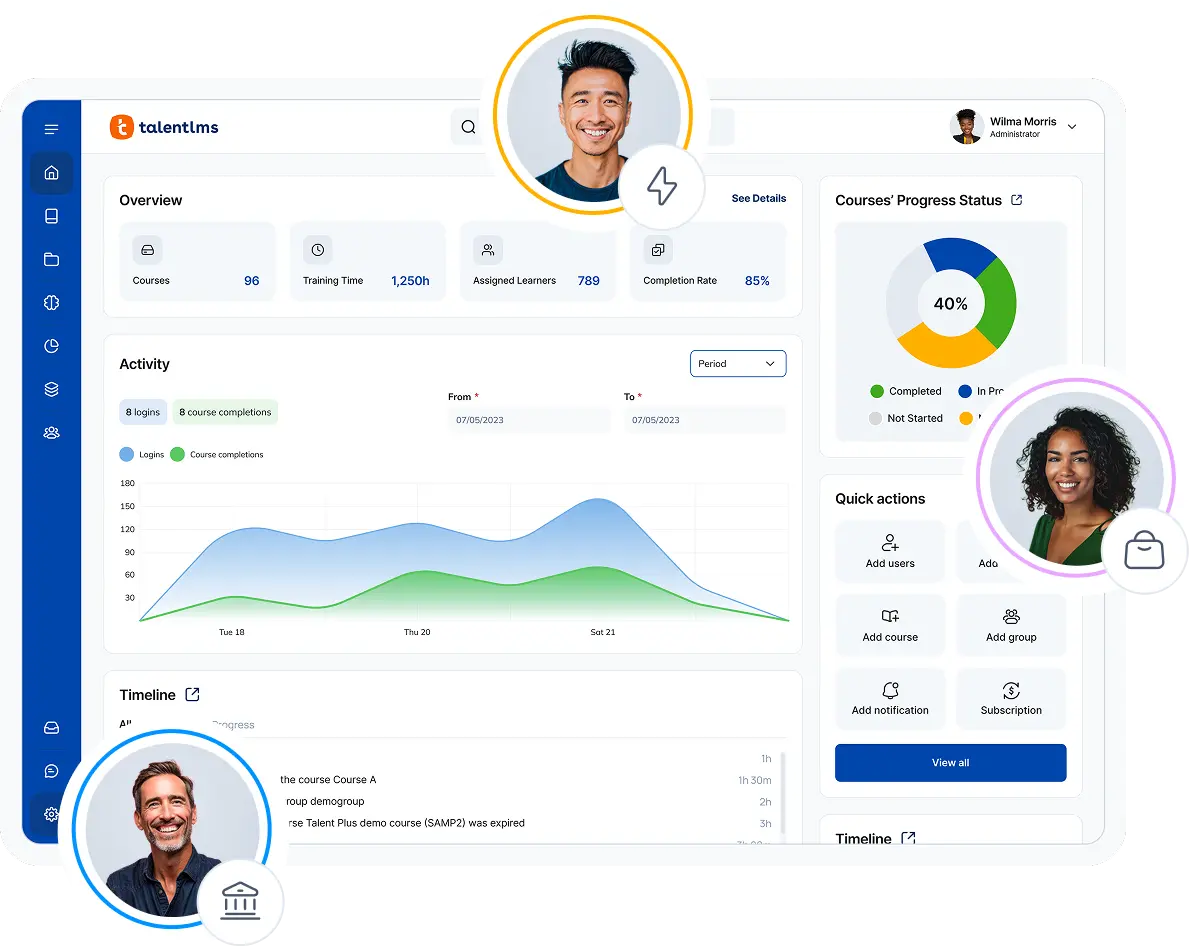
Why we picked it:
We chose TalentLMS as the best iSpring alternative because it keeps pace with growing companies that need more than the basics. It lets teams set up courses in minutes, tap into AI tools to cut down on build time, and connect easily with apps they already use.
Unlike bulkier systems, it doesn’t weigh you down with setup headaches or extra fees just to make it usable, which is why many comparisons of TalentLMS vs iSpring Learn highlight its simplicity. That balance makes it a smart pick for businesses running employee training software, partner programs, or even customer education, where quick access on any device matters.
Pros
- Quick to set up and easy to run day-to-day
- Affordable monthly plans with clear upgrade paths
- Seamless integrations with HR, CRM, and chat apps
- AI tools help speed up course creation
- Strong mobile accessibility for learners on the go
- Flexible branding so teams can match their look and feel
- Gamification elements (points, badges, leaderboards) keep learners engaged
Cons
- Not built for universities or heavy academic use
- Reporting feels basic compared to enterprise-level tools
- May need add-ons for highly specialized learning needs
Key features:
-
- AI course creation
- Gamification and certifications
- Detailed reporting and analytics
- LTI 1.3 (iSpring-compatible integration)
Best for:
SMBs, employee, customer, partner training, onboarding, compliance
Pricing:
Free plan available. Premium trial. Paid plans start from $119/month for 40 users, with details laid out on the official TalentLMS pricing page.
What users are saying on G2
The Good
“I love the ability to use AI and also have free range for customization. There are so many areas that we can leverage to enhance the training we provide. The reporting has been extremely beneficial and provides helpful data. We were able to implement the content easily and quickly with an extremely high adoption rate. We had no issues transitioning from our prior platform to TalentLMS, and it has already saved us hours of training time.” – Katina L. 5/5 stars
The Room for Improvement
“I´d love to have more customization options, e.g., using our company font.” – Anonymous, 4 / 5
iSpring Learn alternative #2: Docebo
Docebo is the LMS companies turn to once their training programs outgrow lighter systems. It shines in large organizations where thousands of learners need consistent experiences across regions and departments.
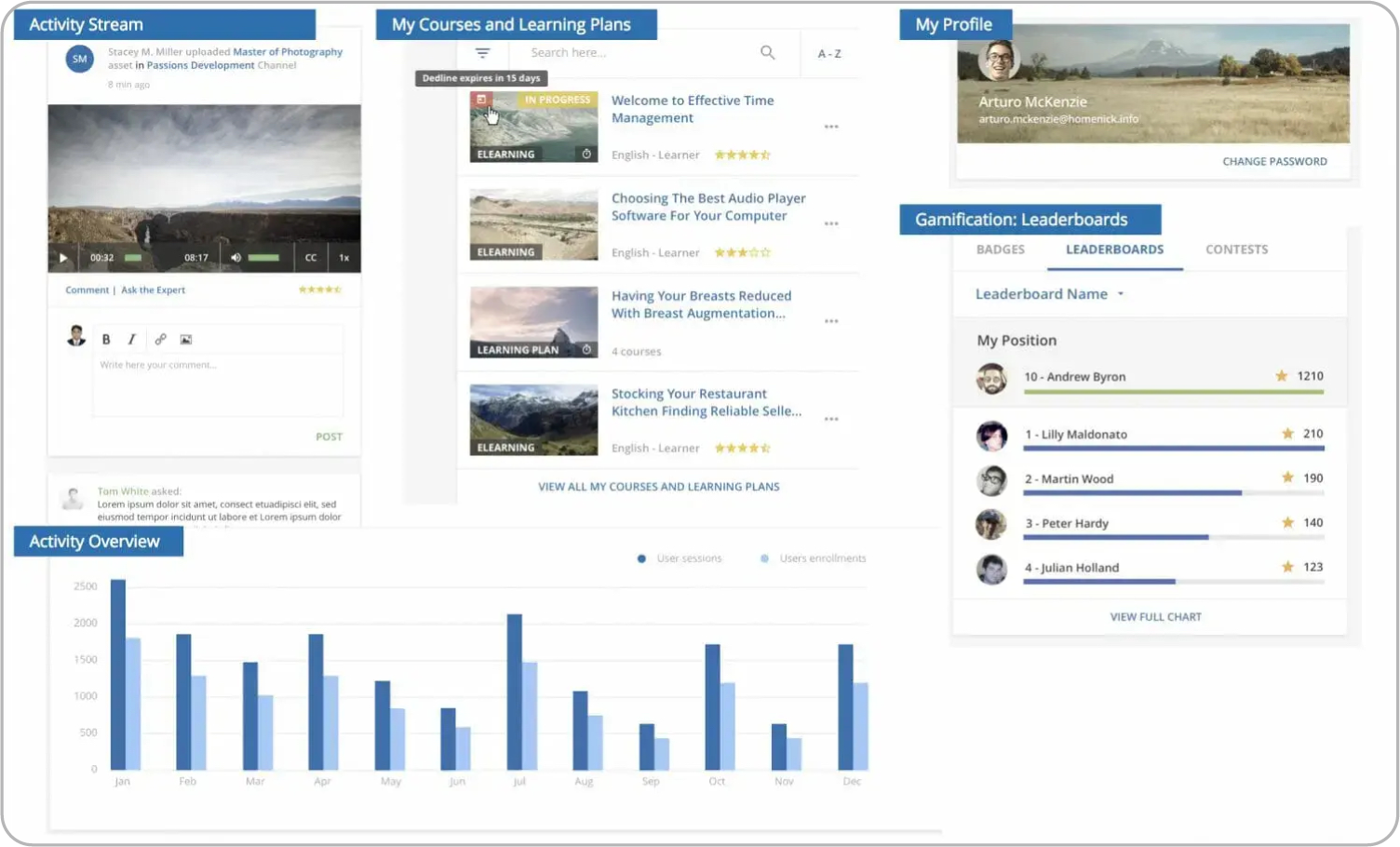
Why we picked it:
We chose Docebo as the second iSpring Learning alternative because it gives learning leaders tools they can’t find in simpler systems. Its reporting digs into learner behavior with real depth, making it easier to spot patterns and measure results. The AI also adapts the customizable learning paths over time, which helps keep training relevant at scale.
Pros
- AI-driven recommendations keep courses relevant
- Automated enrollments save time for admins
- Deep analytics track learner progress across large groups
- White-labeling and broad integrations
Cons
- High entry cost, often out of reach for small teams
- Setup takes longer than iSpring Learn or TalentLMS
- Complexity can frustrate smaller organizations
- Gamification tools feel lighter compared to TalentLMS
Key features:
-
- AI-powered recommendations and course creation
- Advanced automated enrollment
- White labeling and in-depth integrations
- Scalable with robust analytics.
Best for:
Mid-sized to enterprise organizations with complex training needs
Pricing:
Two tiers: Elevate (sources mention ~$40,000/year), and Enterprise (custom quote). No public pricing on their website.
What users are saying on G2
The Good
“The platform allows for flexibility in how we deliver the learning experience, it performs rather well without frequent bugs or crashes – stability is really important for us in the organization. The experience with customer representatives is also quite positive.” -Mateusz D. 4/5 stars
The Room for Improvement
“Docebo needs to work on going back to basics and refining admin and end-user experiences.” – Robert B., 3 / 5 stars
iSpring Learn alternative #3: Absorb LMS
For organizations where compliance training is central, Absorb feels purpose-built. It balances strict requirements with a smooth learner experience, which is why it appeals to large organizations spread across different locations.
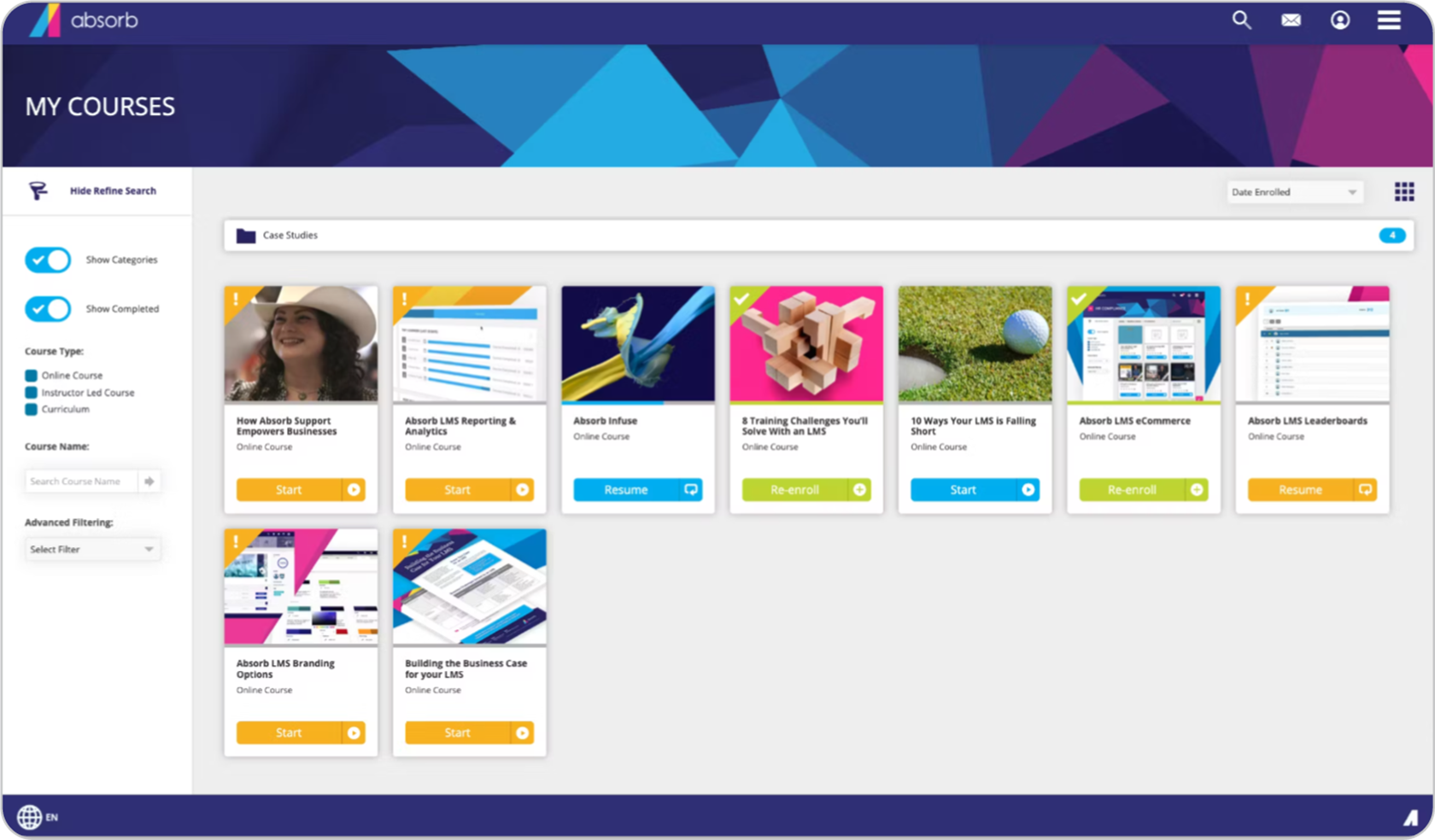
Why we picked it:
We picked Absorb because it helps compliance-heavy teams stay on track without overwhelming learners. Its reporting goes deep enough to satisfy auditors, while the interface stays intuitive for everyday use. Course creation is flexible, and admins can manage complex catalogs without constant firefighting.
Pros
- Strong compliance management with detailed tracking
- Clean, intuitive interface
- Supports large, distributed organizations smoothly
- Scales well for compliance-driven industries
Cons
- Less affordable than TalentLMS for smaller teams
- Reporting is solid, but not as flexible as Docebo’s enterprise analytics
- Customization options fall short compared to iSpring Learn’s built-in authoring
- Fewer gamification elements than TalentLMS, which may limit learner engagement
Key features
-
- AI-assisted content and assessment creation
- Responsive, modern interface
- Blended learning, advanced automation, and strong analytics
Best for:
Enterprises with global deployment needs
Pricing:
No public pricing. Ask for a custom quote.
What users are saying on G2
The Good
“What I like best about Absorb LMS is its user interface and flexibility. Even if you are not as familiar with LMS software, the backend experience is pretty easy to navigate. The platform makes it easy for both administrators and learners, which significantly reduces the learning curve. I also appreciate the reporting tools and automation features. Additionally, the system’s ability to support a wide range of content formats.” – Autumn L. 5/5
The Room for Improvement
“Absorb Create is very limited. I had high hopes at first, but it’s basically PowerPoint. The ‘create with AI’ tool doesn’t yield usable results. The review process drives me (and all my stakeholders) crazy – you have to first designate each individual reviewer with Admin status in the LMS, THEN add them as reviewers in Create for your module.” – Claire S., 3 / 5 stars
iSpring Learn alternative #4: Moodle
Moodle has been around for more than two decades, and in that time, it has grown into the world’s most widely used open-source learning platform. Universities, schools, and nonprofits lean on it because they can shape the system to fit their unique learning environments rather than bending to a vendor’s rules.
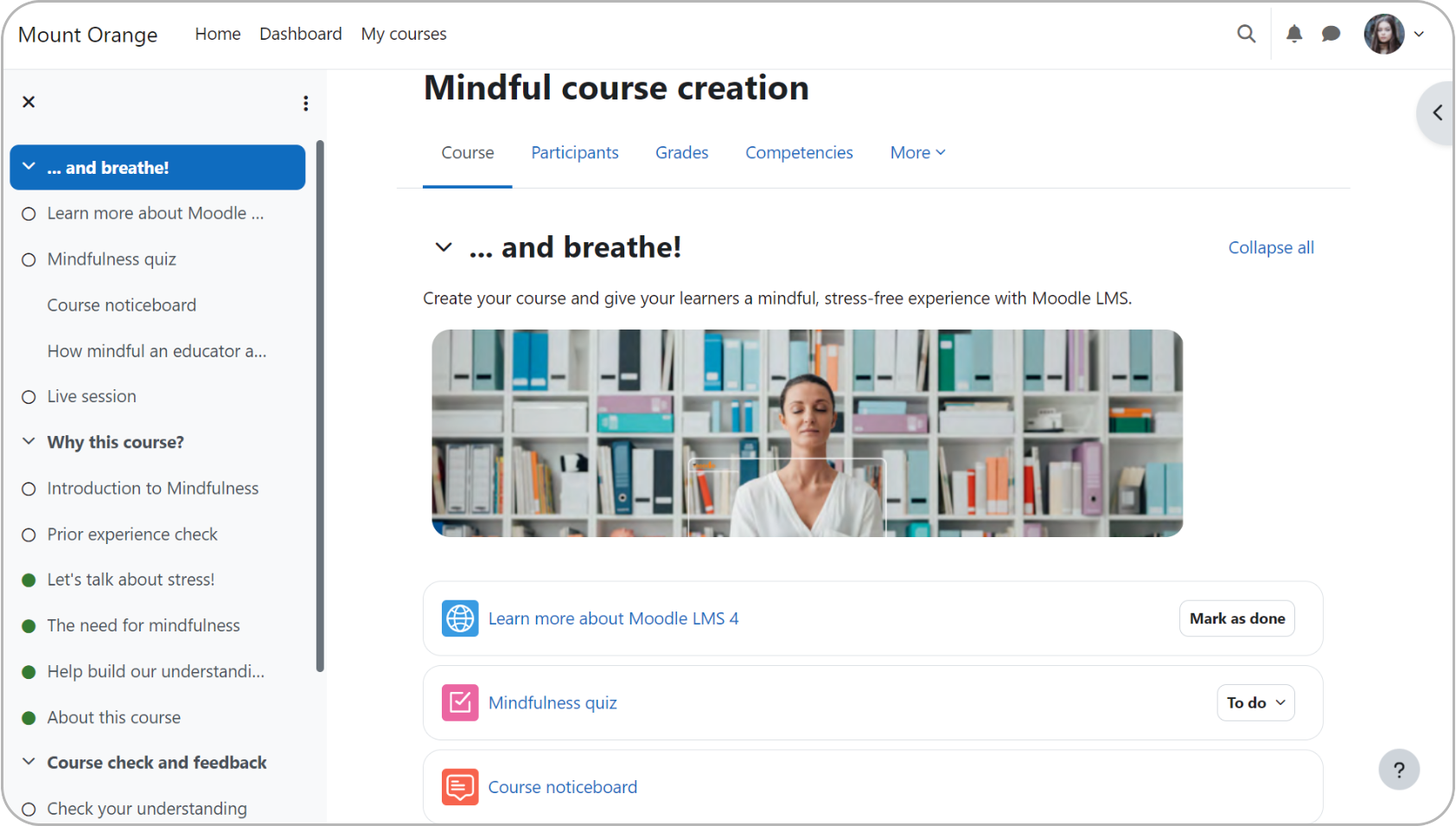
Why we picked it:
We picked Moodle because it brings freedom that proprietary systems can’t match. With an active global community and a library of plugins, institutions can adapt it for everything from language courses to medical training. It does require technical know-how, but for organizations with IT resources, that tradeoff opens the door to deep customization and cost control.
Pros
- Completely open source, with no licensing fees
- Massive plugin ecosystem for customization
- Widely adopted across K–12 and higher education worldwide
- Active global community and long track record
Cons
- Setup and maintenance demands strong IT support
- User interface feels less polished than Absorb or TalentLMS
- Reporting tools are weaker than iSpring Learn or Docebo
- Gamification and engagement tools lag behind TalentLMS
Key features:
-
- Comprehensive assessment and grading tools
- Community plugins
- Customizable with strong developer support
Best for:
Educational institutions (schools, universities)
Pricing
Free open-source, paid Moodle Cloud hosting and partners
What users are saying on G2
The Good
“Moodle is an effective tool to organize educational content in modules and integrate apps or activities from other platforms.” – Felix N., 4.5 / 5 stars
The Room for Improvement
“The downsides, unfortunately, are also there. It feels clunky and not very user-friendly compared to other LMS systems. It feels outdated and not really intuitive.” – Pelser U., 2 / 5 stars
iSpring Learn alternative #5: Litmos
SAP Litmos has carved out a reputation as a go-to choice for corporations that need scalable training quickly across borders. It is known for reliability, broad integrations, and a mobile-friendly approach that makes it easier to reach frontline workers as well as office staff.
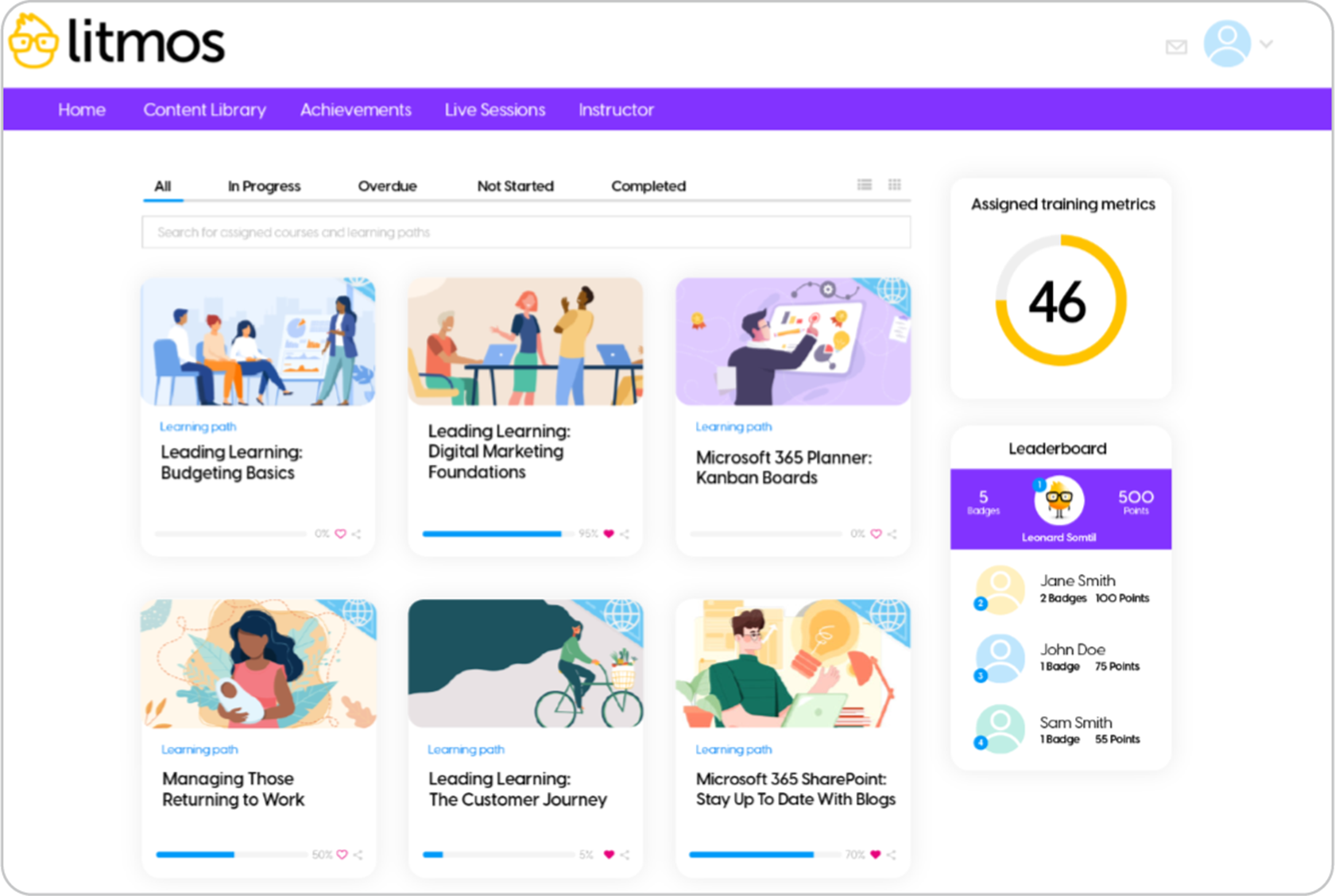
Why we picked it:
We picked Litmos as an iSpring Learning alternative because it combines speed and structure. Companies can launch compliance and skills development training without long setup cycles, thanks to its ready-to-go modules and integration library. The platform also leans heavily on mobile learning, which makes it stand out in industries with distributed workforces. While it’s less customizable than open-source or high-end enterprise tools, its efficiency explains its widespread corporate adoption.
Pros
- Quick deployment with ready-made modules
- Strong out-of-the-box integrations
- Mobile-friendly, designed for frontline access
- Widely adopted for compliance and corporate training
Cons
- Less customizable than Moodle or iSpring Learn
- Reporting is not as deep as Docebo
- Pricing can be high compared with TalentLMS
- Gamification feels lighter than TalentLMS
Key features:
-
- AI assistant for learners
- Workflow and compliance automation
- Strong integration capabilities
Best for:
Enterprises, especially those seeking rapid global rollout
Pricing:
Two tiers: Foundation and Platinum AI, no public pricing available. Sources mention plans start from 18K yearly.
What users are saying on G2
The Good
“I love that it is user-friendly, especially from an admin side. I love being able to track things easily and add engagement; the gamification features are unmatched! It was easy to implement for my team; we use it weekly, and it fits really well into our learning plans/training. Their customer support is always very helpful and patient.” – Halle P. 4 / 5
The Room for Improvement
“Litmos’ platform has many issues. The support for these issues is all external to the US, and typically slow, and doesn’t resolve issues. Typically, I have to troubleshoot and resolve on my own. The platform is not scalable and is especially not useful for teams outside of computers. They don’t offer classroom-style training for manufacturing. Setting up the system is very difficult and not user-friendly, meaning a few admins have to do the majority of the work.” – Anonymous, 2.5/5 stars
iSpring Learn alternative #6: Thinkific
Thinkific stands apart from most corporate LMS platforms because it was built with course sellers in mind. Coaches, consultants, and small businesses use it to design polished, market-ready online courses. Instead of managing compliance or large teams, it shines when the goal is knowledge sharing and reaching paying learners.
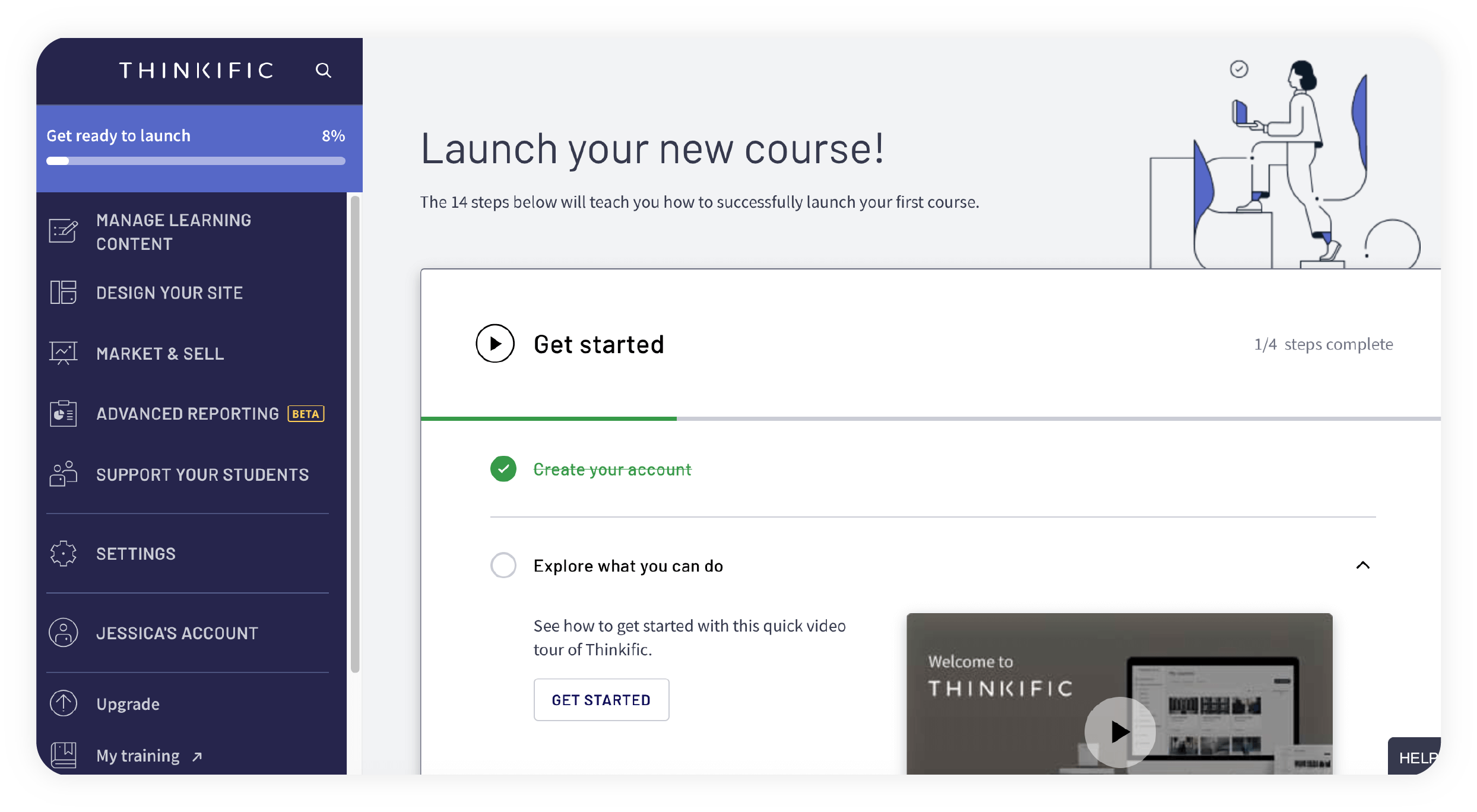
Why we picked it:
We picked Thinkific because it helps individuals and small teams turn expertise into a product. The platform handles course creation, custom branding, and payment gateways in one place, removing the need for extra tools, which is something iSpring Learn heavily lacks. While it’s not designed for internal workforce training at scale, it’s a strong fit for educators and entrepreneurs who want to monetize knowledge.
Thinkific’s free plan also positions it as one of the more practical iSpring Suite free alternatives for solo educators and small teams testing online course delivery.
Pros
- Built for selling courses online, not just internal training
- Clean design makes it easy to build polished courses
- Payments and checkout are built right into the platform
- Strong branding options for creators and small businesses
Cons
- Lacks compliance tools that iSpring Learn and Litmos handle
- Reporting is lighter than Docebo or TalentLMS
- Limited integrations for HR and corporate systems
- Engagement tools feel simpler than TalentLMS’s gamification
Key features:
-
- Drag-and-drop course builder
- Built-in eCommerce and payment tools
- Student engagement
Best for:
Freelancers, creators, course-sellers
Pricing:
Free tier available; paid from $36/month (billed annually)
What users are saying on G2
The Good
“I chose Thinkific because I did not want to just “sell online courses.” I wanted to truly teach those who bought my courses. Thinkific’s features like submittable homework assignments, drip schedules, and prerequisite filters allow me to ensure that my students are truly engaging with the course they purchased.” – Alysha K., 4 / 5 stars
The Room for Improvement
“The price is extortionate for the features provided.” – Anonymous, 0.5 / 5 stars
iSpring Learn alternative #7: Tovuti LMS
Tovuti appeals to teams that want training to feel engaging right away. It blends fast setup with interactive tools like quizzes, games, and virtual classrooms. For mid-sized organizations that need more than static slideshows, it delivers a platform designed to keep learners active and involved from day one.
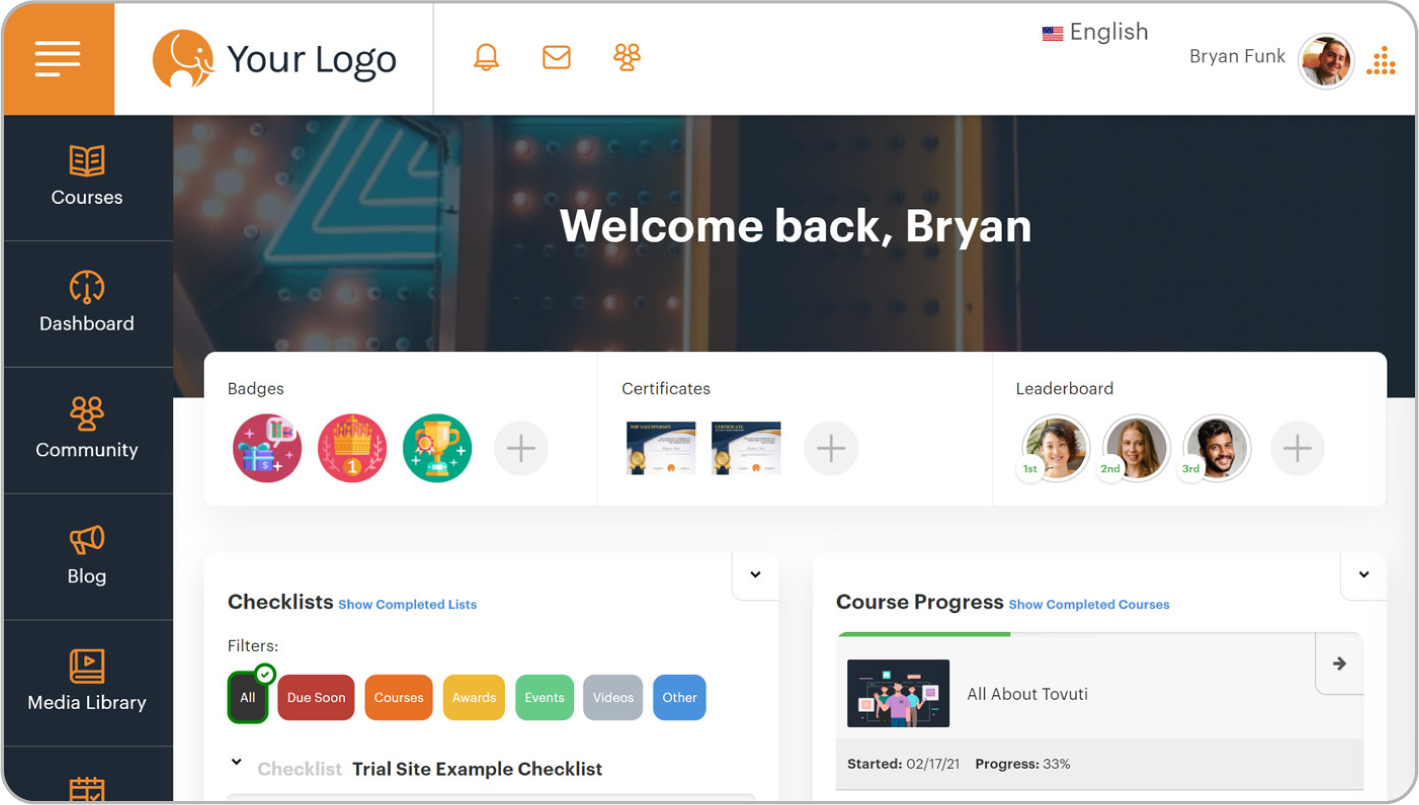
Why we picked it:
We picked Tovuti because it strikes a rare balance between speed and depth. Unlike heavier enterprise platforms, it can be up and running quickly without sacrificing room to grow. Its customization options and advanced features are good for companies that want training to feel lively and branded. But the downside is that it costs more and is more complicated than simpler tools.
Pros
- Quick to launch compared with enterprise-heavy systems
- Rich library of interactive elements like gamification and quizzes
- Flexible branding and customization to match the company identity
- Built-in virtual classrooms support collaborative learning
Cons
- Pricing is higher than TalentLMS and iSpring Learn
- It can feel complex to manage without dedicated admins
- Reporting is not as deep as Docebo’s analytics
- Lacks the large prebuilt content catalogs found in Absorb or Litmos
Key Features:
-
- Drag-and-drop builder
- Gamification and compliance tracking
- Virtual classroom and event management
Best suited for:
Growing SMBs
Pricing:
Custom plans, no public pricing available.
What users are saying on G2
The Good
“Tovuti has really helped to transform the training process at my company. We are able to create many large courses and smaller lessons, really honing in on our company’s values, goals, processes, and procedures. It has helped streamline our onboarding process with new employees.” – Anonymous, 4/5 stars
The Room for Improvement
“Tovuti seems to invest most in its content creation tools rather than improving the overall platform experience. We have received feedback from most of our learners across Fortune 500 organizations that the navigation experience is unintuitive and have had to create introductory content showing learners exactly how to navigate the platform.” – Anonymous, 2/5 stars
Which iSpring alternative to choose
The right platform depends on what you need most. A small team looking for quick setup and simple course creation may find iSpring Learn a perfect fit, especially with its built-in authoring tools, PowerPoint conversion, and learner support.
However, those scaling fast or looking into iSpring Suite alternatives often move to TalentLMS, Docebo, or Absorb. And it might be better to lean on these platforms from the start, so that the transition is removed and everything just flows smoothly from the outset.
In the end, start by asking whether simplicity or scalability matters more, then pick from the iSpring LMS alternatives that best clear the roadblocks in your way.
For a step-by-step checklist, see this how to choose an LMS guide.


